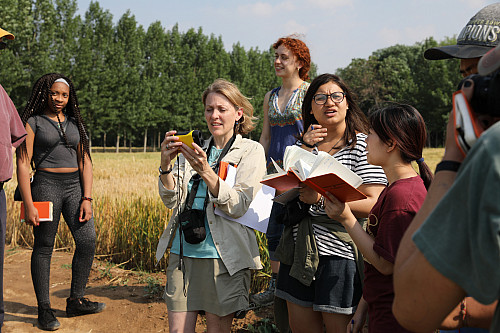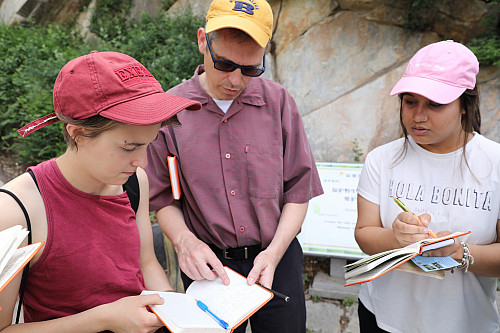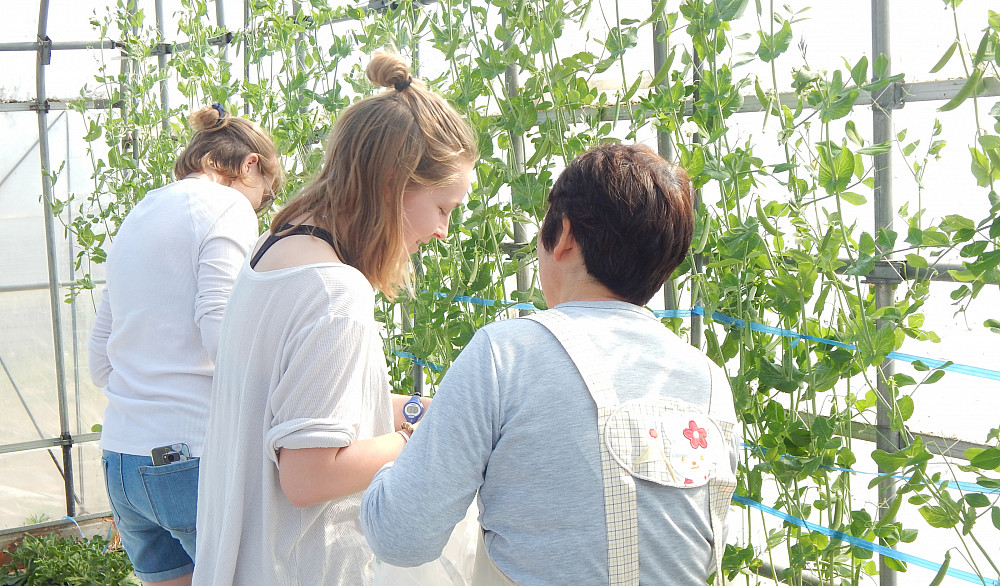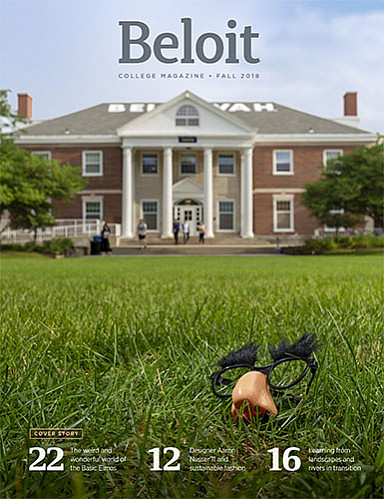Exploring Landscapes and Rivers in Transition
Ziming “Simon” Wu’20 grew up in Dongguan, an industrial city in the Pearl River Delta of central Guangdong Province in South China. Until the spring of 2017, he’d never visited the Yellow River in northern China, but he was aware of its importance to Chinese culture and history.
“We’ve always been told that the Yellow River is the mother river of all Chinese people—where Chinese culture originated—so I was pretty excited about an opportunity to study it,” Wu says.
That opportunity came through a new Beloit program that invites students to conduct field studies in two locations in Asia.
Called “Landscapes in Transition: Environment, Culture, and Society in China and Japan,” the program explores issues of water and land usage in China’s Yellow River basin and in Japan’s agritourism industry. Landscapes in Transition is funded by a four-year $400,000 grant from the Luce Foundation’s Initiative on Asian Studies and the Environment, which encourages innovative approaches to teaching and learning about critical topics affecting the continent. Beloit’s Landscapes in Transition program takes advantage of the college’s faculty expertise in Asian studies and its connections with China and Japan, while also fostering the development of Asia-related courses in various disciplines.

Credit: Ziming “Simon” Wu’20“We want to encourage students in both the humanities and the sciences to think critically about issues affecting Asia, and to consider art, literature, politics, science—really, all perspectives—when attempting to understand those issues,” says Weeks Professor in Physical and Human Geography Sue Swanson, one of four Landscapes in Transition faculty leaders. The program addresses the need to help students understand critical global issues, such as water and food scarcity, from views outside the United States or the West, Swanson says.
“Asia is such an important player in the global economy,” she says. “Asia’s environmental challenges are global challenges, so it’s crucial that our students don’t restrict their understanding of the world’s problems to one perspective. They need to learn about the critical issues of the future by asking good questions now.”
The program is two-pronged. China: Rivers in Transition partners with Henan University—an exchange partner with Beloit since 2006—and its Yellow River Research Institute to study the interaction between water and humankind in the Yellow River basin. Japan: Rural Landscapes in Transition partners with Akita International University, an exchange partner since 2009, to examine how extreme population decline is affecting farming and land usage in rural Japan. The two programs alternate years for traveling to Asia in the spring, with the China field studies offered in 2017 and 2019 and the Japan field studies offered in 2018 and 2020.
Students who apply for the three-week field studies are encouraged to take Beloit courses that provide an academic foundation for the research they will conduct while in Asia. Courses include First-Year Initiatives seminars, such as those focused on themes of water scarcity, alternatives to big agriculture, and nature versus wilderness, and others that range across disciplines, from geology, political science, and history to art history, anthropology, and chemistry. Language study in Chinese or Japanese is not required to participate in the field studies, but it is strongly encouraged.
“Landscapes asks students to wrestle with issues in Asia—whether it’s understanding water scarcity, aging, or preserving cultural heritage—by using varying viewpoints and methodologies to work together to understand that one person or one discipline can’t solve the world’s problems,” says Director of International Education Elizabeth Brewer, who worked with faculty to obtain the Luce grant, awarded in 2016.
For Wu, who is majoring in art history, history, and East Asian studies, the China: Rivers in Transition program was a perfect fit.
“I was drawn to the idea of doing research in my home country and using my Chinese to help my classmates navigate the culture,” Wu says, noting that his field study experience in China included perspectives culled from each of his majors to better understand the environmental, cultural, and historical significance of the Yellow River over time.
The Yellow River
China: Rivers in Transition was developed in part thanks to a $50,000 Luce Foundation exploratory grant that Beloit received in 2014. That grant encouraged bridging the humanities and the sciences in examining Asia’s environmental challenges and supported a small group of faculty members as they traveled to China’s Yellow River basin in summer 2015 to learn more about the region.

Credit: Ziming “Simon” Wu’20The trip led faculty to develop teaching units in Beloit’s art history, physics, and political science departments around themes of environment and sustainability along the Yellow River. It also helped Swanson and Daniel Youd, professor of Chinese language and literature, realize they could team-teach about the environmental and cultural impact of the basin, despite their very different academic backgrounds.
“From a geomorphologic perspective, and for those of us who study water resources, the Yellow River is a case study of a very dynamic river system,” says Swanson, whose specialty is hydrogeology, or the study of ground and surface water interactions. For those who study Chinese history, Youd says, the Yellow River is widely considered the birthplace of modern China, marking its historical and cultural significance in sustaining the entire region.
“I was hooked by the idea of studying the Yellow River as the epicenter of early Chinese cultural activity,” says Youd, whose research interests include Ming and Qing dynasty vernacular fiction, science fiction, utopian literature, drama, and intellectual history.
Coupled with Beloit’s already established relationship with Henan University in the heart of the Yellow River basin, the area emerged as an ideal location for experiential learning. Swanson and Youd worked with Wu Pengfei, a professor at Henan’s Yellow River Research Institute, to develop collaborative, interdisciplinary research projects that used literature, language, art, science, spatial analysis and mapping to understand the cultural history of the region. They focused on three locations: The city of Kaifeng and the banks of the Yellow River north of the city, the Shang Dynasty archaeological site in Anyang, and Song Dynasty sites in Gongyi.
To prepare for field studies in China, Wu and nine other students selected for the program—whose majors ranged from Asian studies to dance to geology and more—began their work in an orientation course in spring 2017. They prepared field guides for the three major research sites, using rare 18th- and 19th-century maps of the river systems in Henan Province—available digitally from the Library of Congress—to formulate research questions they hoped to pursue once in China.
“Maps are great tools for looking at how culture encodes itself into descriptions of a physical landscape,” Youd says.
Once in China, Youd, Swanson, the 10 Beloit students, and eight graduate students from Henan University formed four teams to investigate the interface between the physical geography, geology, and human culture of the Yellow River basin. One group studied the impact of repeated flooding over time in the city of Kaifeng, using maps to compare and contrast the city’s historical and modern-day layouts.
“They studied how the river affected the cultural features of Kaifeng by comparing how flooding shaped the character of neighborhoods. For example, were residential areas still residential? Did they have temples or government buildings now or in the past?” Swanson says.
Another group looked at how the Chinese government has controlled the Yellow River over the span of 700 years, studying the structure of both historical and modern-day dikes and investigating flood-control effectiveness and impact on the surrounding landscape.
The third group studied the material culture of the Shang dynasty. They visited archaeological museums in Anyang, learning what valuable items were made of and where those materials were sourced, prompting discussions about how the local climate and river migration had impacted resources. (Anyang once was located on the Yellow River, but no longer is.)

“I wanted to learn where the mapmakers stood as they drew them to share the viewpoint of the artist,” Wu says. “It was fascinating that a geographical work could also be an artistic creation.”
Wu was so intrigued by his field study in China that he traveled to the Library of Congress to view the original maps once he returned to the United States. He is currently writing a paper—with Youd’s guidance—that examines how artistic technique relates to natural landscapes, including what an artist might choose to include on a map and what might be left out. “The landscapes we studied are complicated and the maps are pretty simple, so that raises questions about the map’s functionality,” he says.
Landscapes and Culture
All of the students’ field studies considered the overarching concepts of how landscape forms a culture and how culture changes a landscape, Youd says.
“They looked at the deep impact that human activity has on the environment and how human beings are capable of making landscapes livable, but also capable of creating disasters—such as flooding—by what they do,” he says.
Students applied concepts from both the sciences and the humanities to understand water resources and management, in China for example, as well as strengthen their ability to interpret public representations of the past, present, and future.
“This program invites students to see what’s possible at the intersection of the sciences and the humanities,” Youd says. “We want them to get excited about looking at issues and topics through different lenses.”
And while the Landscapes in Transition program piques students’ interests in studying issues affecting Asia, it more broadly strengthens their ability to be adaptable and flexible no matter the topic.
Susan Furukawa, assistant professor of Japanese Language and Literature, developed the Japan component of Landscapes in Transition. She sees students gaining valuable skills from participating in the program.
“They learn to contribute to research effectively, even in an unfamiliar country,” says Furukawa. “They become critical observers, as well as gain a degree of intercultural literacy and the ability to consider ideas from various fields, putting that knowledge to use in new and interesting ways.”
An Aging Rural Population and Land Use in Japan

Credit: Susan Furukawa
Susan Furukawa, assistant professor of Japanese language and literature, was part of the Beloit faculty group that toured China’s Yellow River basin in 2015 with the support of a Luce Foundation exploratory grant. Furukawa had been looking for ways to expand Beloit’s capacity to teach about Japan and was asked to help strengthen the college’s grant proposal by creating a component on Japan that paralleled the program faculty were developing on the Yellow River in China.
She and James Rougvie, associate professor of geology, later traveled to Japan to work with faculty members at Akita International University and its Institute for Asian Studies and Regional Collaboration to develop research projects around issues of land usage, laying the groundwork to include Japan in Beloit’s grant application. In addition to supporting field studies, the funding makes possible faculty development opportunities in Japan. Several Beloit faculty members traveled to Japan in the summer of 2017 and more will go in summer of 2019 to study issues around sustainability with the goal of modifying their teaching to include units focused on Japan through topics such as agricultural economics, environmental writing, and the sociology of aging.
This past spring, Furukawa and Rougvie, along with Akita professor Yoshitaka Kumagai, led the Japan program’s first field studies in Akita Prefecture. They guided nine students from Beloit and one student from Akita in investigating how a shrinking and aging rural population has impacted agriculture and how agritourism is helping to sustain and revitalize the region.
“The most pressing issue for Japan’s small communities is rapid population decline,” Furukawa says. “Japan reached its peak population of 128 million in 2011. It’s estimated that by 2100, its population will be 47 million, which is a precipitous drop.”
Semboku, a municipality formed in 2005 from the merging of several villages, served as home base for the Rural Landscapes in Transition group. They looked at how farm homestays—in which domestic and international visitors stay on a working farm, eat locally sourced food, and contribute to the farmers’ income stream—help sustain the communities of Nishiki, Tazawa, and Kakunodate in Semboku.
The students got a firsthand look at farm homestay management by living on one as a group for 11 days, then separating into smaller teams of two or three students each to observe at an additional farm homestay for two days. These experiences helped inform the core of their research: interviewing the owners of 18 farm homestays in the region to further understand how agritourism helps sustain the area’s landscape and agriculture, as well as its traditions and culture.
“The students’ interview questions ranged from asking farmers about their day-to-day lives and why they chose to operate a farm homestay to what they’ve learned from their visitors and how they shared their culture,” Rougvie says. “By also living on a farm and harvesting spinach, chopping wood, and helping in other ways, the students were investigating and partaking at the same time.”
The group also heard briefings from people involved in supporting agritourism, from Nishiki’s mayor to a design firm responsible for farm homestay promotion to an Akita Prefecture official, who shared data indicating that farm homestay owners were more likely to continue farming longer than those who didn’t run agritourism businesses.
“One of the lessons we took away was that agritourism is helping to sustain the practice of farming and to support the maintenance of the land, at least for the near future,” says Zowie Fox’20, an environmental geology and Japanese major. “However, because the population is declining and there aren’t obvious successors to the farms, agritourism may not be a long-term solution. It’s not an easy issue to solve.”
Fox has continued to study issues of Japanese land management as a McNair Scholar at Beloit, working with Furukawa to examine how population decline is impacting satoyama, a constructed landscape of cultivated fields, ponds, streams, forests, villages, and rice paddies that relies on human maintenance. This fall, Fox has returned to Japan as an exchange student at AIU.
Rural Landscapes in Transition also proved useful in comparing attitudes and approaches to agritourism in both Japan and the American Midwest. During their orientation course at Beloit, to prepare for their work in Japan, students interviewed farmers operating homestays in northern Illinois and southern Wisconsin
“There was a common sense of wanting to share the rural lifestyle with others,” Rougvie says. “A lot of the issues affecting rural Japan, such as depopulation and rural out-migration, are happening in the United States, so the comparisons got students thinking about sustainability on a global level.”
Marla Holt is a freelance writer based in Owatonna, Minnesota.


